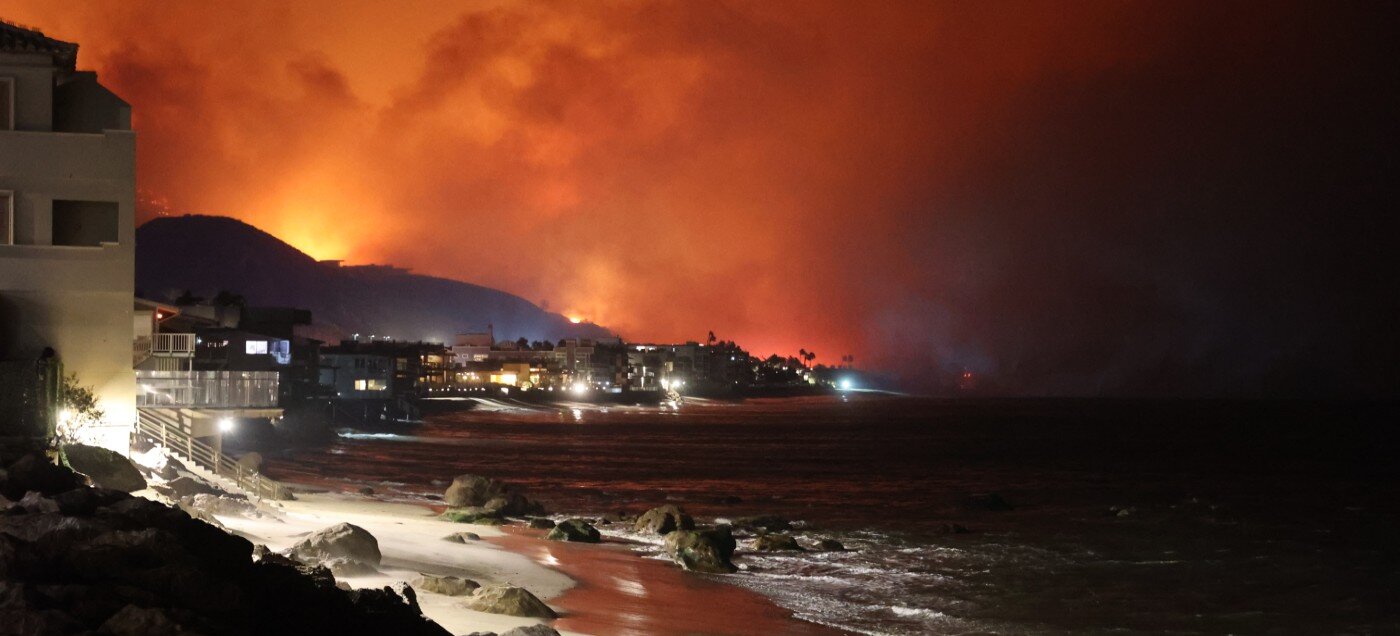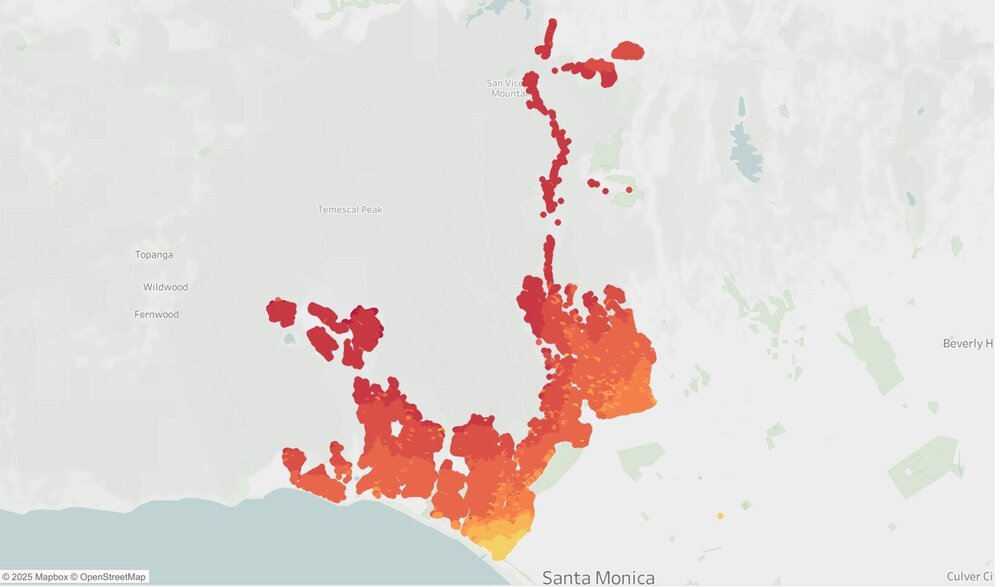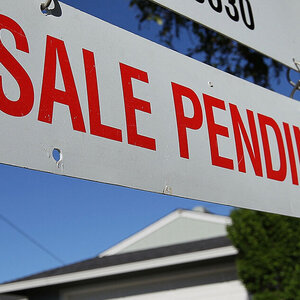Residential Real Estate News

Los Angeles Area Wildfires Destroyed Nearly $52 Billion in Homes Last January
Residential News » Pacific Palisades Edition | By Michael Gerrity | July 30, 2025 8:37 AM ET
The median price of homes destroyed by wildfire was $3.7 million
Wildfires that ravaged Pacific Palisades, Malibu and Los Angeles areas for 3 weeks last January scorched an estimated $51.7 billion in residential real estate, marking one of the most financially devastating wildfire events in U.S. urban history, according to a new analysis by Redfin.
The analysis, based on data from the Los Angeles City Council and matched with Redfin's proprietary valuation models, found that approximately 11,000 homes--mostly single-family residences--were affected by the blazes. The majority of the damage stemmed from the Palisades Fire, which state officials now rank as the third most destructive wildfire in California's history.
The Los Angeles Department of Building and Safety conducted inspections on 11,125 residential parcels following the January fires. Redfin successfully matched nearly 11,000 of those properties with its estimated valuations from December 2024, just before the fires hit. While not all homes were completely destroyed, many suffered catastrophic loss.
Among the findings:
- The median pre-fire home value was $3.7 million
- Nearly 100 homes were worth over $20 million
- The average size of affected homes was 2,916 square fee
- Total damaged residential square footage topped 36.7 million
- The typical home was built in 1957
- Most properties had a First Street Foundation fire risk score of 5, classified as "major"
"These are not just structures--they're entire communities, wiped out," said Greg Eubanks, a local agent with Redfin Premier. "Many homeowners are in limbo, renting while they navigate insurance claims and consider whether to rebuild, relocate, or sell."
The impact has been particularly acute in high-income enclaves like Pacific Palisades, where multimillion-dollar homes were reduced to ash. However, Eubanks noted that resale activity in those areas has slowed to a crawl due to high lot prices and the absence of functioning infrastructure. "In some neighborhoods, basic services like grocery stores are still offline," he said. "That's a tough environment for investors."
Importantly, Redfin's analysis excludes damage from the separate Eaton Fire, which tore through nearby Altadena, suggesting that the true value of residential losses across Los Angeles County is likely significantly higher than the $51.7 billion estimate.
Fire risk scores cited in the report are based on the First Street Foundation's climate risk model, which blends historical wildfire activity with forward-looking climate projections. The risk ratings reflect ongoing environmental exposure rather than past fire events alone.
As the city faces a long road to recovery, Los Angeles is once again confronting the economic reality of climate-intensified disasters in some of the nation's most expensive and fire-prone neighborhoods.
Sign Up Free | The WPJ Weekly Newsletter
Relevant real estate news.
Actionable market intelligence.
Right to your inbox every week.
Real Estate Listings Showcase
Related News Stories
Residential Real Estate Headlines
- U.S. New-Home Sales Surge in August as Mortgage Rates Ease
- Despite Increased Foreign Buyer Activity, Miami Residential Sales Dip 11 Percent in August
- California Home Sales Enjoy Modest Uptick as Mortgage Rates Ease
- U.S. Home-Flipping Profits Sink to Lowest Level Since 2008 Financial Crisis as Costs Climb
- Why the World's Rich Are Flocking to Europe in 2025
- Federal Reserve Delivers First Rate Cut of 2025 as Mortgage Relief Proves Limited
- Homebuilder Sentiment Holds Steady in U.S. as Rate-Cut Bets Lift Outlook
- U.S. Mortgage Rates Experience Sharpest Weekly Drop in Over a Year
- U.S. Foreclosures Rise for Sixth Straight Month as Affordability Pressures Mount
- Black U.S. Homeownership Rate Falls to Two-Year Low as Job Losses Mount
- Las Vegas Home Prices Flatten as Listings Surge, Sales Slow
- Cooling Miami Housing Market Sees 16 Percent Annual Sales Drop in July
- U.S. Mortgage Delinquencies Uptick in June Amid Regional Pressures
- California, Florida Top U.S. Housing Markets Most at Risk of Downturn
- 30-Year Mortgage Drops to 6.56 Percent in Late August, Lowest Since October 2024
- Investors Maintain Elevated Role in U.S. Housing Market Despite Slight Pullback
- Pending Home Sales Show Mixed Signals as U.S. Buyers Remain Cautious
- Canadian Home Sales Extend Recovery in July
- U.S. Home Sales Rise in July as Buyers Gain More Bargaining Power
- Zombie Foreclosures Edge Up Across U.S.
- 2.6 Million Homes at Wildfire Risk Across 14 Western States in 2025
- One in Five Americans Willing to Trade Personal Safety for Home Affordability
- U.S. Home Price Growth Slows as Affordability Pressures Mount in 2025
- U.S. Mortgage Rates Dip to Four Month Low in Early August
- U.S. Mortgage Applications Rise in Late July, Breaking Four-Week Slump
- Hong Kong's Housing Market Stuck in Stalemate as Bulls and Bears Face Off
- U.S. Condo Market Struggles in 2025
- U.S. Pending Home Sales Remain Sluggish in June
- Los Angeles Area Wildfires Destroyed Nearly $52 Billion in Homes Last January
- Greater Palm Beach Area Residential Sales Slip in June Amid Growing Inventory
- Economic Resilience Lifts U.S. Housing Outlook Going Forward
- New Home Sales Stagnate as Affordability Struggles Continue in America
- U.S. Housing Market Slips in June as Prices Hit New Highs
- Florida, California Continue to Reign Supreme as America's Ultraluxury Housing Markets
- Caribbean Housing Market Evolves into Global Second-Home Hotspot
- U.S. Home Sales See Highest June Cancellation Rate on Record
- Orlando Housing Market Cools in June as Listings Slide, Sales Slow
- Private Credit Surges in 2025 as Real Estate Developers Bypass Banks
- U.S. Condo Market Suffers Sharpest Price Drops in Over a Decade as Buyers Retreat
- Rising Taxes, Insurance Costs Undermine the Stability of U.S. Homeownership








